Qualcomm Inc. (NASDAQ:QCOM) of San Diego, CA, is a major developer and designer of telecommunications products as well as many of the semiconductors powering our current generation of mobile electronic devices. This year has been a tough one for the corporation, which has announced cuts of up to 15 percent of its workforce and experienced a 12 percent drop in stock price during August. Qualcomm is also about to see a stronger push from rival chipmaker Intel Corporation (NASDAQ:INTC) which plans to increase its activities in developing chipsets for the growing Internet of Things sector.
The company has been targeting some growth areas, however, and Qualcomm recently unveiled reference designs for an integrated chip designed for use on drones which could bring the price of high-quality unmanned aerial vehicles below $300. The chip, dubbed the Snapdragon Flight, combines navigation, video processing and computation reduces the size of the motherboard, battery and motor for a more cost-effective construction. Another mobile chip announced in late August, the Snapdragon 820, is the first developed by Qualcomm with anti-malware technology designed for smartphones and other mobile devices. In mid-September, Qualcomm’s healthcare division Qualcomm Life acquired healthcare data collection and processing firm Capsule Tech, which markets a home gateway device that collects and encrypts biometric data from patient medical devices for access by medical professionals.
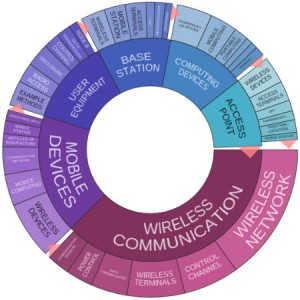 Qualcomm is one of the major players petitioning the U.S. Patent and Trademark Office for patent grants which we cover here on IPWatchdog. In 2014, the corporation was 8th overall among patent-seeking corporations with 2,706 U.S. patent grants that year, an almost 25 percent increase from its 2013 patent totals. In the three months leading up to this writing, Qualcomm had earned 856 U.S. patent grants. In the text cluster posted here, provided by Innography, we can see that wireless communication technology remains a great focus among Qualcomm’s recent R&D, complemented by activity in mobile devices and user equipment.
Qualcomm is one of the major players petitioning the U.S. Patent and Trademark Office for patent grants which we cover here on IPWatchdog. In 2014, the corporation was 8th overall among patent-seeking corporations with 2,706 U.S. patent grants that year, an almost 25 percent increase from its 2013 patent totals. In the three months leading up to this writing, Qualcomm had earned 856 U.S. patent grants. In the text cluster posted here, provided by Innography, we can see that wireless communication technology remains a great focus among Qualcomm’s recent R&D, complemented by activity in mobile devices and user equipment.
[Companies-1]
Qualcomm’s Issued Patents: From Indoor Navigation to Directional Wireless Device Charging
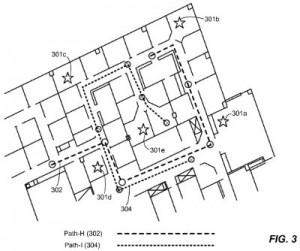 A couple of recently patented Qualcomm technologies relate to systems for navigating indoor venues with the use of a mobile device. U.S. Patent No. 9115997, issued under the title Modeling Characteristics of a Venue, protects a method of identifying a set of constraints regarding available survey time associated with a venue, determining a plurality of paths to be traveled by a mobile device in accordance with the constraints, directing the mobile device to navigate the venue using the paths, receiving data from the mobile device for the dynamic updating of paths and generating a model of the venue using the collected data. This technology is designed to provide better mapping of interior spaces than conventional satellite positioning systems which are much better at mapping outdoor areas. Techniques for delivering indoor navigational tools more effectively to a mobile device are discussed within U.S. Patent No. 9125021, entitled Methods and Apparatuses for Use in Determining That a Mobile Station is at One or More Particular Indoor Regions. This patent discloses a method of receiving preliminary positioning assistance data for an indoor region determined to be nearby a mobile station’s estimated location, transmitting a request for positioning assistance data comprising an electronic map and an access point locator for the indoor region and providing positioning assistance data to positioning, navigation or location-based service functions. This innovation provides assistance data to a mobile device for an indoor region with greater controls to reduce the large amount of data transferred for navigation or location-based services.
A couple of recently patented Qualcomm technologies relate to systems for navigating indoor venues with the use of a mobile device. U.S. Patent No. 9115997, issued under the title Modeling Characteristics of a Venue, protects a method of identifying a set of constraints regarding available survey time associated with a venue, determining a plurality of paths to be traveled by a mobile device in accordance with the constraints, directing the mobile device to navigate the venue using the paths, receiving data from the mobile device for the dynamic updating of paths and generating a model of the venue using the collected data. This technology is designed to provide better mapping of interior spaces than conventional satellite positioning systems which are much better at mapping outdoor areas. Techniques for delivering indoor navigational tools more effectively to a mobile device are discussed within U.S. Patent No. 9125021, entitled Methods and Apparatuses for Use in Determining That a Mobile Station is at One or More Particular Indoor Regions. This patent discloses a method of receiving preliminary positioning assistance data for an indoor region determined to be nearby a mobile station’s estimated location, transmitting a request for positioning assistance data comprising an electronic map and an access point locator for the indoor region and providing positioning assistance data to positioning, navigation or location-based service functions. This innovation provides assistance data to a mobile device for an indoor region with greater controls to reduce the large amount of data transferred for navigation or location-based services.
Qualcomm’s activities in developing digital security solutions is on display within U.S. Patent No. 9118619, which is titled Prevention of Cross Site Request Forgery Attacks by Conditional Use Cookies. The method operational on a web server claimed here involves establishing a web session with a client browser, generating at the web server a first cookie restricted for use with a locally-triggered event and a second cookie restricted for use with an externally-triggered event, sending the first and second cookies to the client browser via a network, receiving a request from the client browser which is accompanied by a cookie and determining whether the cookie is a first or second cookie. This invention was pursued as a means for addressing cross-site request forgery attacks, which send malicious commands from trusted client devices to web servers.
Qualcomm’s offerings in the Internet of Things are ramping up thanks to the issue of a series of recent patents, including U.S. Patent No. 9109943, which is titled Weight-Sensing Surfaces with Wireless Communication for Inventory Tracking. This patent discloses a method of receiving identification and quantity data for consumable items at a central computer system from a first user system comprised of weight sensing devices, determining a consumption metric for the consumable items based on the received data, generating consumption-related information based on the consumption metric and transmitting the consumption-related information to the first user system. This technology enables better monitoring for level of consumables in industrial, commercial and residential settings to analyze nutritional intake or ensure that important supplies are ordered on schedule. The ability to keep many Internet-connected devices in one space supplied with the power they need to perform their various jobs is supported by the invention 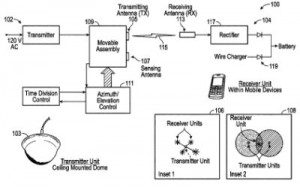 protected through the issue of U.S. Patent No. 9130602, titled Method and Apparatus for Delivering Energy to an Electrical or Electronic Device Via a Wireless Link. The apparatus for providing power to a device disclosed here includes a transmitting antenna operative to wirelessly transmit power to said device, a sensing antenna operative to sense a power level of signals transmitted by the device and a control unit assembly that controls the transmission direction of the transmitting antenna based on the sensed device power levels. This intelligent system for charging electronic devices wirelessly enables greater flexibility when setting up wirelessly powered devices within a room.
protected through the issue of U.S. Patent No. 9130602, titled Method and Apparatus for Delivering Energy to an Electrical or Electronic Device Via a Wireless Link. The apparatus for providing power to a device disclosed here includes a transmitting antenna operative to wirelessly transmit power to said device, a sensing antenna operative to sense a power level of signals transmitted by the device and a control unit assembly that controls the transmission direction of the transmitting antenna based on the sensed device power levels. This intelligent system for charging electronic devices wirelessly enables greater flexibility when setting up wirelessly powered devices within a room.
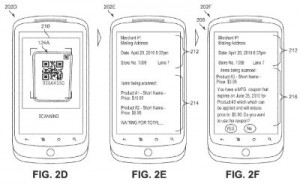 We’ve been noting growing activity this year in the use of computing devices as digital wallets and we were intrigued to see Qualcomm heading into this fray with the issue of U.S. Patent No. 9092776, titled System and Method for Managing Payment in Transactions with a PCD. The method for management payment of a purchase transaction with a personal computing device (PCD) protected here involves receiving a mobile wallet token from an account issuing entity, storing the mobile wallet token in a PCD’s payment platform memory, generating a PCD token corresponding to the mobile wallet token, transmitting the PCD token over a communications network to the PCD, receiving at the PCD payment platform a PCD token associated with a purchase transaction, matching the PCD token with its corresponding mobile wallet token and transmitting the matching mobile wallet token to a merchant system for settlement of the purchase transaction. This technology enables physical tokens like gift cards and stored value cards to be better incorporated into digital wallet services to be redeemed digitally.
We’ve been noting growing activity this year in the use of computing devices as digital wallets and we were intrigued to see Qualcomm heading into this fray with the issue of U.S. Patent No. 9092776, titled System and Method for Managing Payment in Transactions with a PCD. The method for management payment of a purchase transaction with a personal computing device (PCD) protected here involves receiving a mobile wallet token from an account issuing entity, storing the mobile wallet token in a PCD’s payment platform memory, generating a PCD token corresponding to the mobile wallet token, transmitting the PCD token over a communications network to the PCD, receiving at the PCD payment platform a PCD token associated with a purchase transaction, matching the PCD token with its corresponding mobile wallet token and transmitting the matching mobile wallet token to a merchant system for settlement of the purchase transaction. This technology enables physical tokens like gift cards and stored value cards to be better incorporated into digital wallet services to be redeemed digitally.
[JV-1]
Patent Applications of Note: Wireless Charging for Electric Vehicles and Smartphone Barometers
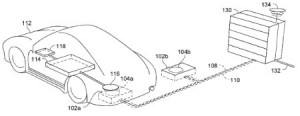 We’ve been closely following the pulse of research and development in electric vehicles (EVs) over the past few months and we noticed a couple of Qualcomm patent applications in this field as well. U.S. Patent Applications No. 20150202970, titled Systems and Methods for Electric Vehicle Induction Coil Alignment, would protect a method of receiving wireless power involving the detection of a transmission signal in a wireless power transmission, the signal varying periodically between two frequencies, as well as a the determination of a phase of a base system induction coil signal based on the detected transmission signal. This invention relates to an improved method for the wireless charging of an electric vehicle. A similar innovation for the wireless charging of EVs is also detailed within U.S. Patent Application No. 20150255205, titled Electric Vehicle Induction Coil Housing with Interengagement Structure for Ferrite Tile Assemblies. The induction coil housing that would be protected here includes a base forming a receptacle and an interengagement structure extending from the base and securing a ferrite tile assembly within the receptacle. This innovation makes use of the ferrimagnetic properties of ferrite, a compound containing iron which is used to produce high-frequency antennas, to create a stronger electromagnetic field for wireless charging.
We’ve been closely following the pulse of research and development in electric vehicles (EVs) over the past few months and we noticed a couple of Qualcomm patent applications in this field as well. U.S. Patent Applications No. 20150202970, titled Systems and Methods for Electric Vehicle Induction Coil Alignment, would protect a method of receiving wireless power involving the detection of a transmission signal in a wireless power transmission, the signal varying periodically between two frequencies, as well as a the determination of a phase of a base system induction coil signal based on the detected transmission signal. This invention relates to an improved method for the wireless charging of an electric vehicle. A similar innovation for the wireless charging of EVs is also detailed within U.S. Patent Application No. 20150255205, titled Electric Vehicle Induction Coil Housing with Interengagement Structure for Ferrite Tile Assemblies. The induction coil housing that would be protected here includes a base forming a receptacle and an interengagement structure extending from the base and securing a ferrite tile assembly within the receptacle. This innovation makes use of the ferrimagnetic properties of ferrite, a compound containing iron which is used to produce high-frequency antennas, to create a stronger electromagnetic field for wireless charging.
Speech recognition was at the center of a couple of inventions coming out of Qualcomm’s R&D labs, such as the push-to-talk (PTT) communications tool featured within U.S. Patent Application No. 20150223110, which is titled Robust Voice-Activated Floor Control. It would protect a method for voice-activated PTT floor control by listening to ambient noise during an idle state in a PTT call, comparing a bitrate associated with the ambient noise to a threshold value indicating normal background noise levels and triggering a request to take a floor in a PTT call in response to the ambient noise bitrate exceeding a threshold until a floor request timer expires. This invention was pursued to provide a more reliable voice activation system for PTT communications that can be triggered with natural conversation. Another speech recognition technology from Qualcomm gives us one of the more interesting patent application  titles we’ve come across on the Companies We Follow series. U.S. Patent Application No. 20150245133, issued under the title Listen to People You Recognize, would protect a method of processing a video image and an audio communication containing signals from two separate microphones associated with the video, identifying a source of the audio communication from the processing of the video image to visually identify the source, determining an angle of a first mobile computing device to the source of the audio communication and contemporaneously displaying on the first mobile computing device a first location information associated with the visual identification of the audio communication’s source as well as a second location information comprising the angle of the mobile computing device to the audio communication’s source. This system for identifying a speaker in telecommunications is intended to help reduce background noise and improve the audio signal quality in video calls.
titles we’ve come across on the Companies We Follow series. U.S. Patent Application No. 20150245133, issued under the title Listen to People You Recognize, would protect a method of processing a video image and an audio communication containing signals from two separate microphones associated with the video, identifying a source of the audio communication from the processing of the video image to visually identify the source, determining an angle of a first mobile computing device to the source of the audio communication and contemporaneously displaying on the first mobile computing device a first location information associated with the visual identification of the audio communication’s source as well as a second location information comprising the angle of the mobile computing device to the audio communication’s source. This system for identifying a speaker in telecommunications is intended to help reduce background noise and improve the audio signal quality in video calls.
Smartphone components can already collect data regarding directional orientation and relative speed but local atmospheric conditions are a new data target for the technology featured within U.S. Patent Application No. 20150247917, entitled Opportunistic Calibration of a Barometer in a Mobile Device. This patent application discloses a method of determining that a mobile device is in an outdoor environment at a ground level, determining that the mobile device is at a discernible altitude level based on a signal obtained from a mobile device sensor and/or an electronic map, and then initiating a calibration process of a mobile device barometer to identify a reference atmospheric pressure level for the altitude level. This innovation intends to provide mobile device users with weather information that can be processed locally without having to retrieve resources over the Internet. A unique component for mobile computing devices which provides a novel user interface is reflected 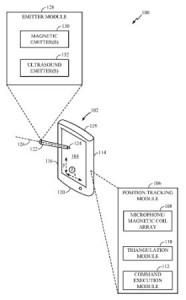 within U.S. Patent Application No. 20150242002, filed under the title In-Air Ultrasound Pen Gestures. This would protect a method of detecting gesture commands using an ultrasonic pen and a user device by acquiring a position of the ultrasonic pen along both an x-axis, a y-axis and a z-axis of the user device and then performing a command based on the acquired positions. This improved ultrasonic pen detection system is capable of identifying finer commands, such as the degree of rotation of a pen, than conventional systems.
within U.S. Patent Application No. 20150242002, filed under the title In-Air Ultrasound Pen Gestures. This would protect a method of detecting gesture commands using an ultrasonic pen and a user device by acquiring a position of the ultrasonic pen along both an x-axis, a y-axis and a z-axis of the user device and then performing a command based on the acquired positions. This improved ultrasonic pen detection system is capable of identifying finer commands, such as the degree of rotation of a pen, than conventional systems.
Finally, we wanted to share a Qualcomm invention for more accurate location estimation techniques processed by a mobile device, expressed within U.S. Patent Application No. 20150226573, titled Pedometer Integrated Pedestrian Positioning. This claims a method of estimating a position of a pedestrian by detecting whether the pedestrian is moving through the use of a movement sensor on the pedestrian, propagating particles representing statistical samples of the pedestrian’s position at a given time based on a predictive pedestrian movement model and updating the pedestrian’s position by a wireless network upon failure of the movement sensor to detect that the pedestrian is moving. This innovation is intended to address shortcomings in conventional pedestrian positioning systems which could erroneously report that a pedestrian was still moving after that person had stopped in place.
___________
Main image licensed under CC 2.0, with some rights reserved.

![[IPWatchdog Logo]](https://ipwatchdog.com/wp-content/themes/IPWatchdog%20-%202023/assets/images/temp/logo-small@2x.png)



![[Advertisement]](https://ipwatchdog.com/wp-content/uploads/2024/04/UnitedLex-May-2-2024-sidebar-700x500-1.jpg)
![[Advertisement]](https://ipwatchdog.com/wp-content/uploads/2024/04/Artificial-Intelligence-2024-REPLAY-sidebar-700x500-corrected.jpg)
![[Advertisement]](https://ipwatchdog.com/wp-content/uploads/2024/04/Patent-Litigation-Masters-2024-sidebar-700x500-1.jpg)

![[Advertisement]](https://ipwatchdog.com/wp-content/uploads/2021/12/WEBINAR-336-x-280-px.png)
![[Advertisement]](https://ipwatchdog.com/wp-content/uploads/2021/12/2021-Patent-Practice-on-Demand-recorded-Feb-2021-336-x-280.jpg)
![[Advertisement]](https://ipwatchdog.com/wp-content/uploads/2021/12/Ad-4-The-Invent-Patent-System™.png)






Join the Discussion
No comments yet.